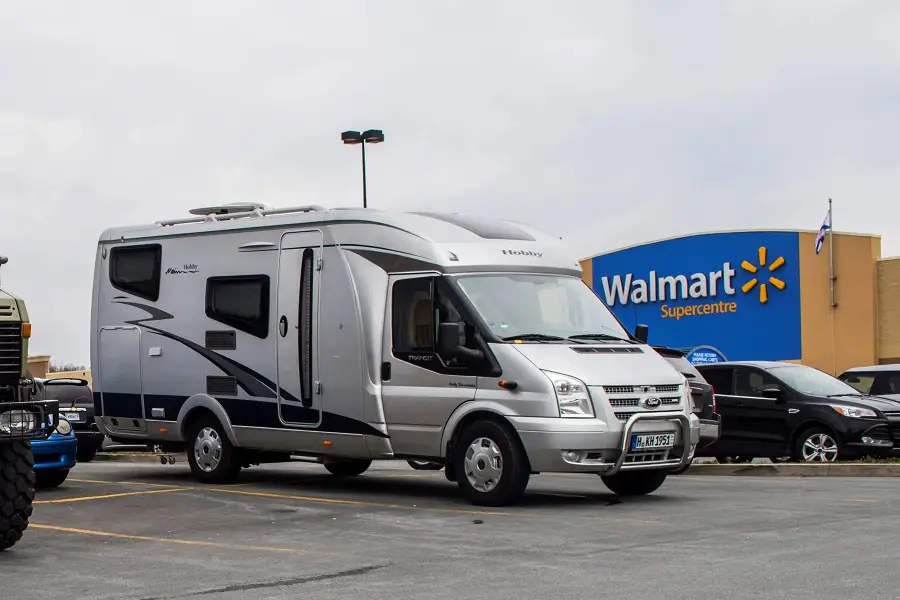One of the most important things we do every single day is sleep, and to do that effectively and rest up, we need to be comfortable.
Sleeping pads are that medium between you and the ground that allow you to be comfortable, and they can even be used in combination with a sleeping bag.
Let’s go over the top sleeping pad first, and work down the list in terms of durability, comfort, and of course, the price tag.
Editor’s Top Choice
Outdoorsman Lab Camping Sleeping Pad
- Best Design for Active Outdoor Enthusiasts: After years of drafting,...
- Perfect for Backpackers and Hikers: The Ultralight sleeping pad can...
- Sleep Better Under the Stars After a Long Day of Hiking: Even though...
Why is it better?
- Great for back sleepers
- Self sealing valve
- Portability
5 Best Camping Sleeping Pads
With that in mind, let’s now take a closer look at our top picks.





Let’s dive into the specifics and review each camping sleeping pad individually. You can use the list below to jump and review specific models, or you can read along and go through all the information.
Best Overall: Outdoorsman Lab Camping Sleeping Pad
- Best Design for Active Outdoor Enthusiasts: After years of drafting,...
- Perfect for Backpackers and Hikers: The Ultralight sleeping pad can...
- Sleep Better Under the Stars After a Long Day of Hiking: Even though...
The Ultralight Sleeping Pad by Outdoorsman Lab is a cult-classic compact sleeping pad with a unique air-cell design.
This self-adjusting sleeping pad is surprisingly comfortable, despite it being only about 2″ thick.
We whole-heartedly recommend this sleeping pad for every camper, but backpackers will especially appreciate it’s low weight, compactness, and overall durability.
The Ultralight Sleeping Pad has an impressive 4.3-star rating on Amazon, with over 1,700 customer reviews. We’ve found that this ultralight pad is truly worthy of its high rating, especially when considering that it has few drawbacks.
Pros
- Less noisy/squeaky than typical air sleeping pads
- Great for back sleepers
- Self-sealing valve keeps air in while you’re inflating
- Almost half the size of standard camp sleeping pads
- Incredible cost vs value when it comes to price
Cons
- Air valve located at foot of pad can make topping up tricky in a crowded tent
- Slimmer width might feel inadequate for sleepers that like plenty of elbow space
Features
- Super tiny packed size (8″ x 3″) makes it perfect for fitting into a backpack
- R-value of 1.3 makes this pad best for camping in temperatures above 50F
- Takes 15 breathes or less to inflate and even less time to deflate
- Outdoorsman Lab offers a Limited Lifetime Warranty on this pad
Product Information
- Weight: 16 oz
- Dimensions: 73″ x 21.5″ x 2.2″
- Packed size: 8″ (height) x 3″ (diameter)
- Material: 20D ripstop nylon top / 75D polyester bottom
- Color options: Orange, Green, and Blue
Runner Up: Therm-a-Rest Camping Sleeping Pad
- Plush Fabrics: Light, soft fabrics make this sleeping pad...
- Thick: 2-inch (5 cm) thickness provides a high level of warmth and...
- Self-Inflating: Compressible foam core expands when sleeping pad is...
While putting together our best sleeping pad guide, we wanted to include one runner-up that almost made it into the top spot:
Therm-a-Rest is an outdoor gear brand best known for their sleeping pads.
Their pads are often touted as being very comfortable, with models that often extremely impressive warmth ( high R-value).
The Basecamp Self-Inflating Foam Camping Pad is a great example of their products.
The Basecamp is a sturdy camping pad with a pretty traditional designed. It offers a lot of support and, despite being made of foam, is quite breathable.
Pros
- Range of 3 different sizes to suit all
- Perfect for extremely cold camping
- Updated self-inflating and deflating design
- No-frills classic look
Cons
- Heavy weight
- Fairly basic comfort level overall
Features
- Comes in 3 sizes to choose from – Regular (R), Long (L), and XLarge (XL)
- Polyester fabric is light and airy, without losing warmth
- Solid foam core that self-inflates for added plushness
Product Information
- Weight: 2 lbs 8 oz (R), 3 lbs 6 oz (L), 4 lbs (XL)
- Dimensions: 20″ x 72″ (R), 25″ x 77″ (L), 30″ x 77″ (XL)
- Packed size: 21″ x 7″, 26″ x 7.5″, 31″ x 7.5″
- Material: 75D polyester and Urethane foam
- R-value: 5.8
Best Under $50: FreeLand Camping Sleeping Pad
The Freeland Self-Inflating Camping Sleeping Pad is an example of a very well-designed sleeping pad that would be a great as a first sleeping pad or as a back-up for campers that often take their family or friends.
Priced well under $50, this Freeland pad actually has some really neat features than more expensive pads don’t, such as a built-in pillow.
Its large size, numerous color options, and self-inflating design are just the icing on the cake.
Pros
- Attached pillow means space-savings and no more sleeping on a balled up jacket
- Larger sizing for a lower price than a standard pad
- Made of tear-resistant, durable materials
- Self-inflation and deflation
- 72hr leakage inspection tested prior to sale
Cons
- Self-inflation can take longer than expected
- Pillow attachment must be manually inflated
- Does not have a tested R-value
Features
- Dual, free-flowing air valves for self-inflation and quick deflation
- Open cell foam-core offers more stability than air-only pads
- Split joint sides allow you to connect this pad to others
- Comes with compression straps and stuff sack for storage
- Comes with a patch kit for emergencies
Product Information
- Weight: 3.3 lbs
- Dimensions: 76″ x 24.8″ x 1.5″
- Packed size: 15″ (height) x 6.7″ (diameter)
- Material: 190T polyester pongee fabric
- Color options: Teal, Dark Blue, Green, and Light Blue
Best With Memory Foam: Better Habitat Camping Sleeping Pad
Memory foam mattresses are skyrocketing in popularity, so it only makes sense that campers who value comfort above all else are crazy about foam sleeping pads.
There are quite a few foam-only pads on the market, but they tend to have poor reviews when it comes to overall quality and longevity.
We did the research and found that the best foam sleeping pad is BetterHabitat’s SleepReady Memory Foam Floor Mattress.
This pad is not your typical camping sleeping pad, but rather a camping mattress of sorts.
Car or RV campers that don’t need to pack around their sleeping pad will find that this pad is worth every penny.
Pros
- Zero inflation needed – just unclip, unroll, and go
- Non-slip and water-resistant bottom
- Built-in carrying handle and protective carrying bag
- Extra-roomy design
- Separate kid-size option
- Full 1-year manufacturer warranty
Cons
- Higher price compared to similarly sized mattresses
- Tends to absorb moisture
- Heavy size not suitable for backpacking
Features
- Solid 3″ thick mat offers premium comfort for all styles of sleepers, including side
- Ideal for those with chronic joint or back pain
- Comes with a fitted waterproof cotton sheet
- Oversized carrying bag lets you pack in a sheet or blanket as well
- Comes in standard Twin size or Kid’s
Product Information
- Weight: – 17lbs or 18lbs packed
- Dimensions: – 76″ x 36″ x 3″
- Packed Size: – 36″ (height) x 18″ (diameter)
- R-value: N/A
- Weight limit: up to 230lbs
Best Large-Size Pad: TETON Sports Outfitter XXL Pad
- CAMP COMFORTABLY: Thick, comfortable camping pad feels just like your...
- EXTRA INSULATION AND COMFORT: Camping pad provides another layer of...
- LIGHTWEIGHT AND EASY TO USE: Easy to carry to the campsite; Roll-up...
Finding a sleeping pad that is suitable for camping or backpacking but is roomy enough for bigger guys can be a struggle.
Thankfully with some hard work, we discovered the TETON Sports Outfitter XXL Camp Pad.
The Outfitter XXL Camp Pad has over 700 positive reviews on Amazon with a solid 4.4-star rating.
Despite being such a large pad, it’s surprisingly lightweight and compact.
This model also has a few other features that come in handy.
Pros
- Zero inflation needed – just unclip, unroll, and go
- Non-slip and water-resistant bottom
- Built-in carrying handle and protective carrying bag
- Extra-roomy design
- Separate kid-size option
- Full 1-year manufacturer warranty
Cons
- Higher price compared to similarly sized mattresses
- Tends to absorb moisture
- Heavy size not suitable for backpacking
Features
- Sewn-in side pocket for stashing small objects
- Built-in pillow pocket keeps pillow in place while sleeping
- Built-in compression straps with roll-assist (no stuff sack)
- Foam-only design doesn’t need inflation
- Surprisingly lightweight compared to size
- Impressive R6.2 makes it perfect for winter camping
Product Information
- Weight: 9lbs
- Dimensions: 82″ x 38″ x 2.5″
- Packed size: 38.5″ (height) x 13.5″ (diameter)
- R-value: 6.2
What To Look For In A Camping Sleeping Pad?
There are 3 main factors to consider when you’re shopping for a sleeping pad – size, construction, and R-value.
Size
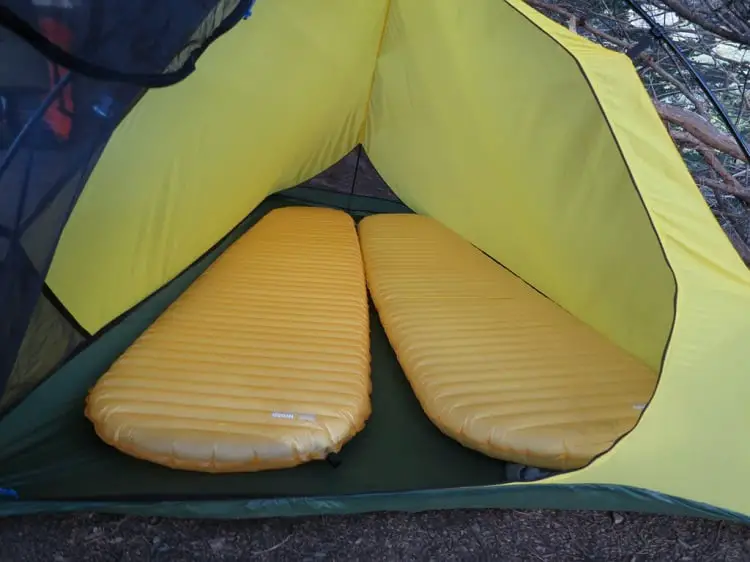
Sleeping pads come in a number of sizes, typically regular(R), Long (L), and Extra-Large (XL).
Most people will find regular-sized sleeping pads to offer plenty of space. Long and XL pads are better for tall or wide individuals or if you’re sharing a pad with someone else.
Try to pick a size that offers just enough width and length to be comfortable. Since you’ll likely be using a sleeping bag, the extra space of an XL pad used with a standard mummy bag will just go to waste.
If you plan on sleeping directly on your sleeping pad with a quilt over top, then you can effectively go as big as you’d like with your sleeping pad since you can use every inch.
Construction
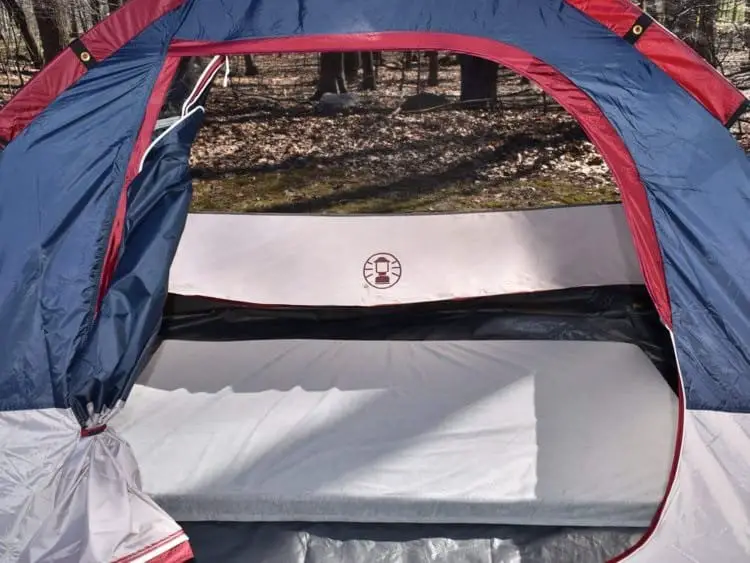
There are 3 main types of sleeping pad styles, which are categorized by their construction.
These include – foam pads, air pads, and foam-core pads.
Foam pads are made solely of some type of foam, with the most comfortable being made of memory foam.
These pads are the heaviest, but also the easiest to use as you since there is nothing to inflate.
They aren’t very compact when it comes to compressibility, making them most suitable for car or RV camping.
Air pads are inflatable sleeping pads that are very lightweight and tend to fold down extremely small.
These are most popular among backpackers and campers that use minimal gear. Air pads may self-inflate or will require you to inflate them manually with your breath.
Foam-core pads offer a cushy medium between foam-only and air-only. These inflate like an air pad and many do have self-inflation capabilities.
They aren’t as bulky or heavy as foam-only, but they have more plushness than air-only.
R-Value
An R-value rating gives you insight into how much insulation a sleeping pad will give. These values are often denoted as R with a number, such as R1 or R5.
The higher the number, the more insulative the sleeping pad will be.
For winter camping, R-value will be important.
If you’re a casual camper that only ventures out in the warmth of summer, then R-value likely won’t affect you much.
Air Beds Vs. Air Mattresses Vs. Sleeping Pads – What’s The Difference?
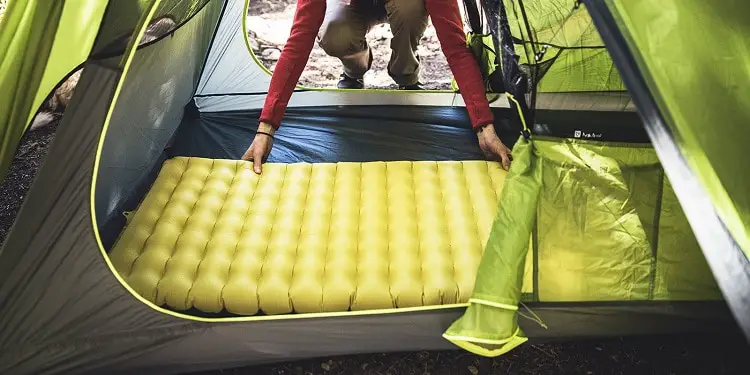
New campers may not be familiar with the differences between air beds, air mattresses, and sleeping pads.
This can make shopping for what you need even more confusing.
Air Beds
Air beds and air mattresses are two terms that are often used interchangeably.
However, traditionally air beds are inflatable plastic beds, which may or may not be the same size as your standard beds (i.e. Twin, Queen, King).
Air beds usually aren’t flocked either nor do they usually have any type of protective material underneath.
While some sleeping pads do inflate with air, they are still properly referred to as sleeping pads and not air beds.
Air Mattresses
Air mattresses often have a soft, flocked top and the higher-end models may even have a non-slip bottom.
Air mattresses also come in standard mattress sizes, with Twin and Queen being the most common. You can certainly find these in Full and King as well.
Sleeping Pads
Sleeping pads are a camping-friendly alternative to air beds of any kind.
They are often smaller, with only the more expensive specialty pads being a Twin size or larger.
Sleeping pads are also not as thick as standard air beds – often only being a few inches thick.
The majority of sleeping pads do not require any type of pump to inflate. Either the sleeping pad will take 10-20 full breaths to inflate or it will self-inflate, depending on the design.
Most foam-based sleeping pads require no inflation and are simply used as is.
The slimmer size of sleeping pads makes it perfect for single-person use within a tent or even in a hammock set up.
They are also exceptionally lightweight and compressible, packing down into a compact shape that can be carried in or on a backpack.
For the majority of camping events, you will want the comfort and durability of a sleeping pad.
In situations where you’re car camping or “glamping“, a lightweight air mattress might be a possibility if weight isn’t an issue and you want a bed-like feel.
What Size Sleeping Pad Should You Buy?
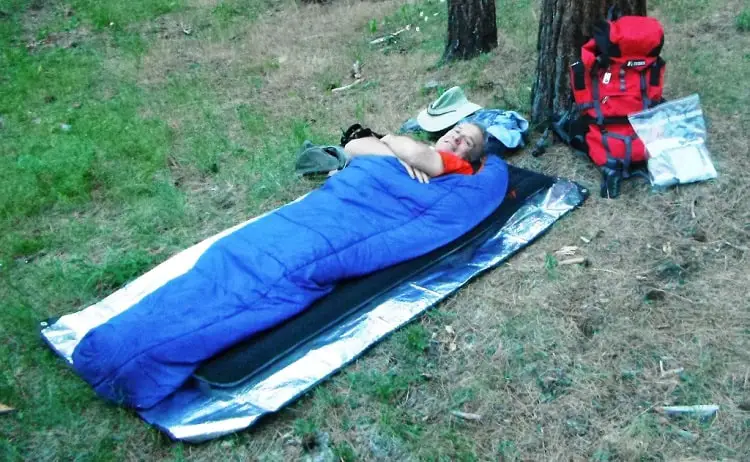
Sleeping pads come in a number of sizes, though they will differ between brands. Most brands will categorize their pad sizing as Regular, Long, and XL.
You can expect Regular/R sleeping pads to offer enough space for the average adult woman or man, up to about 6′ tall.
Taller individuals will benefit from the extra length of a Long/L pad. If you’re overall a larger person in height and weight, then an XL pad will be perfect.
Aside from your height and weight, you also need to consider the size of your shelter. Most 2-person and larger tents will be able to fit at least 2 standard sleeping pads.
If you need an XL pad, you’ll need to double-check the floor dimensions of your tent to make sure the sleeping pad you want will fit.
Don’t forget about the packed size of your pad as well. If you’re car camping then the packed size of a sleeping pad isn’t as much of a concern.
However, if you plan on backpacking, you might regret your decision to get a bulky pad when you’re stuck carrying it for hours.
How To Make A Sleeping Pad More Comfortable?
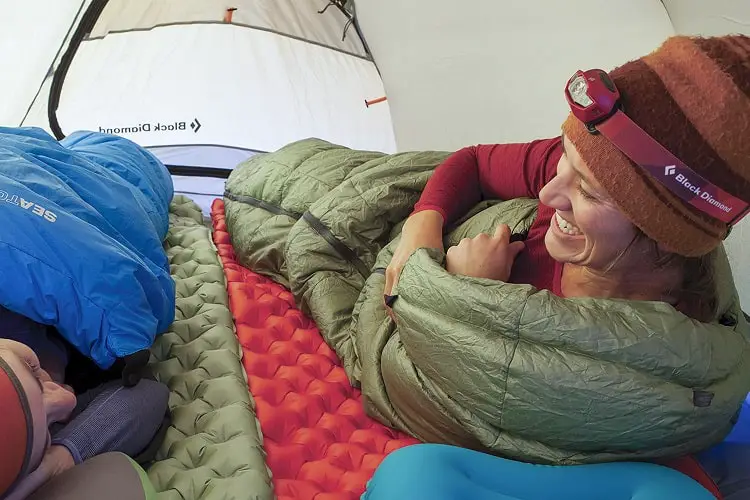
We recommend returning the sleeping pad if you find it to be truly disappointing and uncomfortable.
But if you overall really like the pad and only find it uncomfortable under certain situations, there are usually some quick fixes.
Firstly, always set up your tent on the flattest ground possible.
Sloping, uneven ground or rocky can not only damage your tent floor and your sleeping pad, but they’ll also affect your quality of sleep.
If you’re still finding your sleeping pad to be a little stiff you can look into adding more cushion either between the tent floor and the pad or between your sleeping bag and the pad.
A foam camping mat or even a thick wool blanket can be placed under your sleeping pad to help with shock absorption.
A neat trick is to use interlocking foam flooring pieces, which are quite affordable and effective.
These foam flooring pieces are ideal for bigger tents where you’ll be getting more foot-traffic inside (i.e. a family-size 8 person+ shelter).
A camping quilt can also work well for placing between the sleeping pad and your sleeping bag to add a little more plushness.
What Does R-Value Mean For Sleeping Pads?
R-value is a measurement of thermal resistance that you’ll see when shopping for sleeping pads.
A standard R-value test involves a cold chamber kept at a stable temperature and the use of two metal plates that sandwich the sleeping pad.
The bottom plate has an electrical current running through it at a steady temperature that’s higher than the cold chamber.
The R-value measurement is then taken based on how well the sleeping pad maintains the warmth of the bottom plate.
The less electricity the plate must use to maintain it’s warmer temperature, the more insulative the sleeping pad is.
In simple terms, the higher the R-value rating, the warmer the sleeping pad.
As a general rule, sleeping pads with an R-value of 2 or less are best for summer camping as they offer very little insulation.
Moving up to an R2 to R3 rating would be ideal for general 3-season use. R4 to R5 is reserved for winter camping, while a rating of R5+ is for alpine or extremely cold conditions.
What Do You Put Under A Sleeping Pad?
A well-built sleeping pad will need nothing under it, meaning you should be able to place it directly on your tent floor.
As mentioned earlier, if discomfort is the issue then there are some different options to add more cushion.
If instead, you’re concerned about wear-and-tear or you’re looking for additional warmth, you have a couple options.
A closed cell foam camping mat is a great solution for campers that want a barrier between the tent floor and their sleeping pad for additional warmth.
While it isn’t thick enough to provide much cushion, it will help with thermal insulation.
Worth mentioning is that you can put your sleeping pad on your camping cot.
How To Care For Your Camping Sleeping Pad?
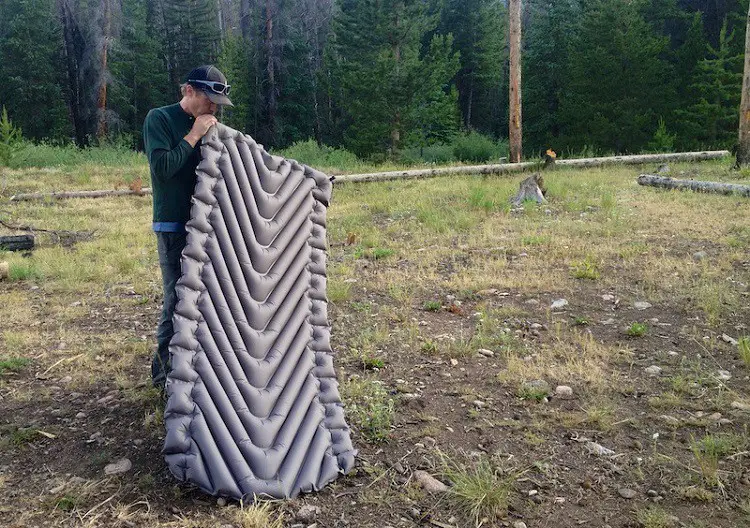
Sleeping pads made of pure foam don’t typically require special care, but air pads and air + foam core pads should be treated a little more carefully.
After all, while a little tear in a foam-only sleeping pad usually isn’t a huge deal, that same small tear in an air pad can mean you’ll literally be sleeping on the ground.
If possible, always try to protect your sleeping pad by keeping in its stuff sack inside your backpack.
Strapping it to the bottom of your backpack will save space, but it also means it’s going to be the first thing that hits the ground when you set your bag down.
When space is tight you can also strap it to the top of your pack. This offers more protection, but only if you’re hiking down easy trails.
Otherwise overhanging trees branches or rocks may snag your pad.
You’ll also want to make sure you follow the manufacturer’s instructions for cleaning and off-season storage.
How To Clean Your Camping Sleeping Pad?
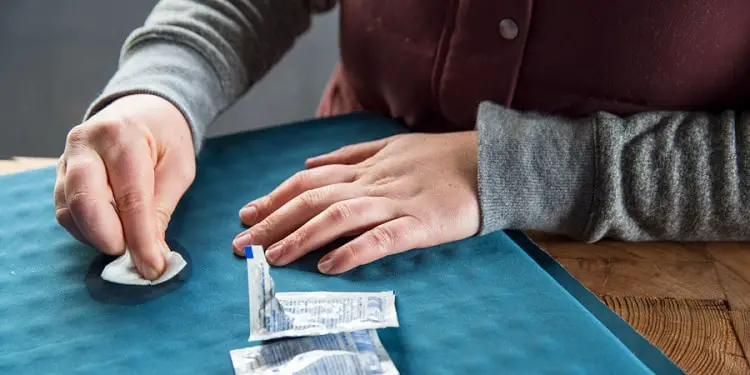
Cleaning a camping sleeping pad is usually pretty straight, but always read what the manufacturer recommends before starting.
After every camping trip you should clean off your sleeping pad.
While a little dust isn’t going to hurt it other substances like insect-repellent sprays, any chemicals, pine sap, or spilled food must be removed. Alcohol wipes or gentle soaps will work well for these types of accidents.
Once your camping season is over it’s time to completely wash the sleeping pad, regardless of how well you’ve been spot cleaning it. The reason for this is to make sure any oils, bacteria, and other grime are 100% removed from the pad before you put it away.
Keep in mind, if you sleeping directly on your sleeping pad without a sleeping bag, you’ll need to fully wash it much more often. Use only manufacturer-approved detergents and cleaning methods when washing your sleeping pad.
After the final wash, you’ll need to completely dry out the pad, ideally outdoors, but not in direct sunlight.
Your now totally clean and dry pad can be stored in your home until the next camping season.
Self-inflating sleeping pads may be left with the valve open and semi-inflated. Air-only pads can be totally deflated and either hung up in a closet or carefully placed back into the stuff sack.
Final Thoughts
The right sleeping pad can completely transform your camping experience and put an end to those restless nights in your tent.
We hope that with the help of this guide, you’ll be able to confidently choose the right sleeping pad and begin enjoying your camping trips that much more.
Let us know, in the comments below, what your favorite sleeping pad is or any other tips for helping fellow campers get a better night’s rest.
Resources:


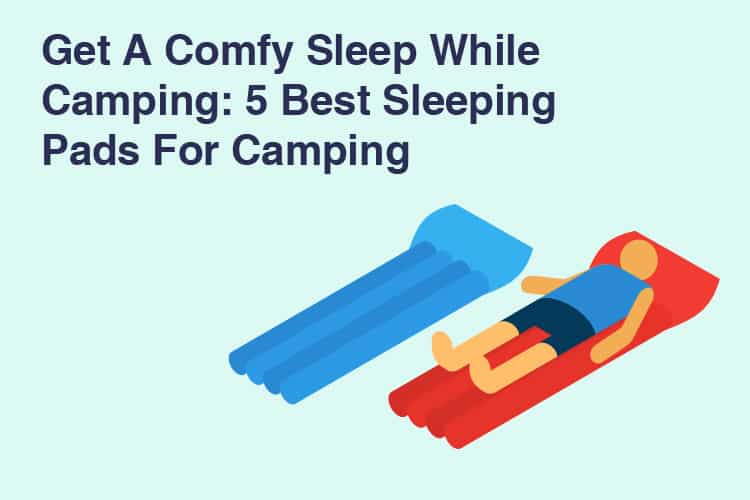

![9 Final Thoughts And Items For Your First Camper Adventure [Checklist] 29 RV Camping Checklist](https://kempoo.com/wp-content/uploads/2018/11/first-camper-adventure.jpg)
